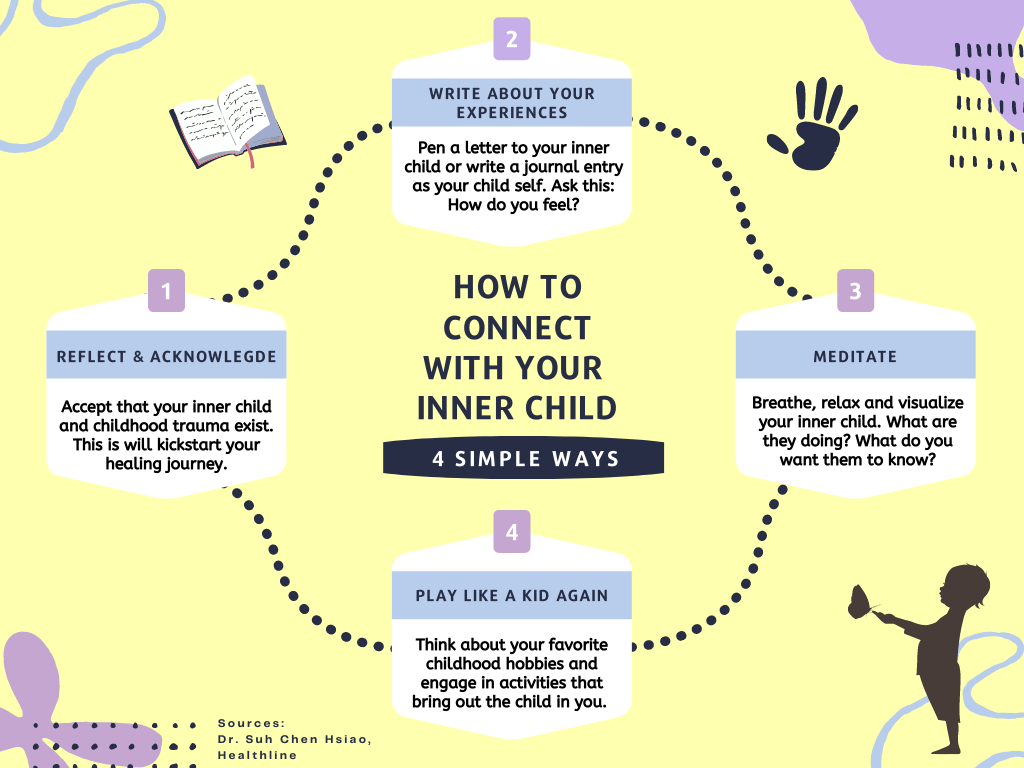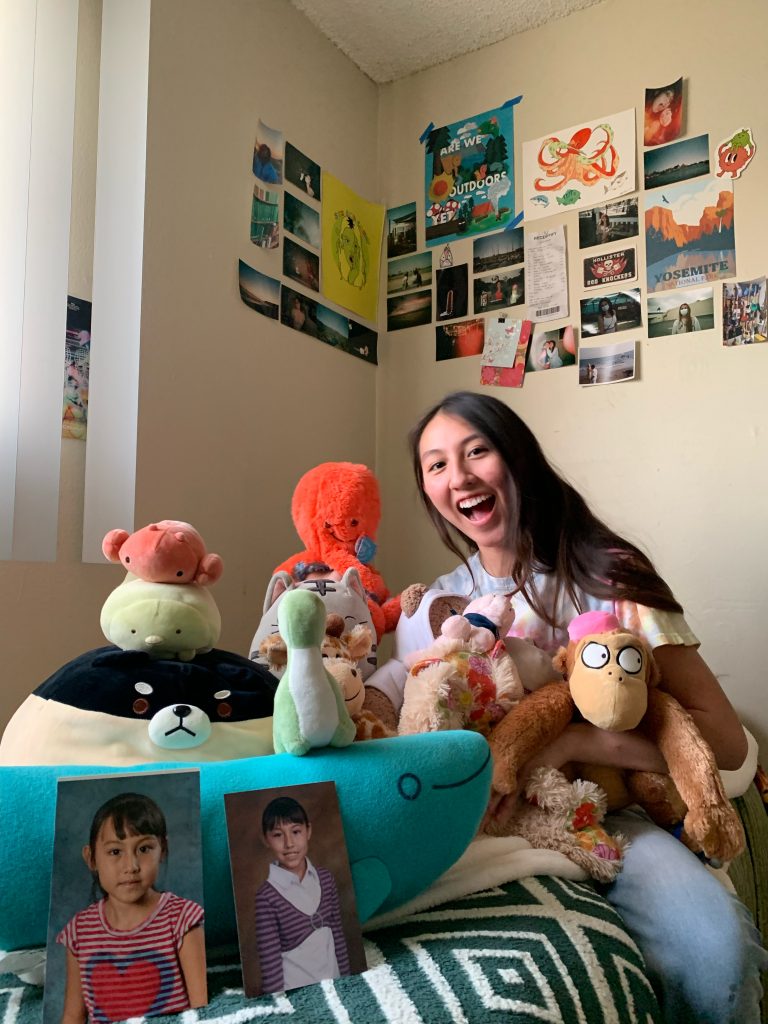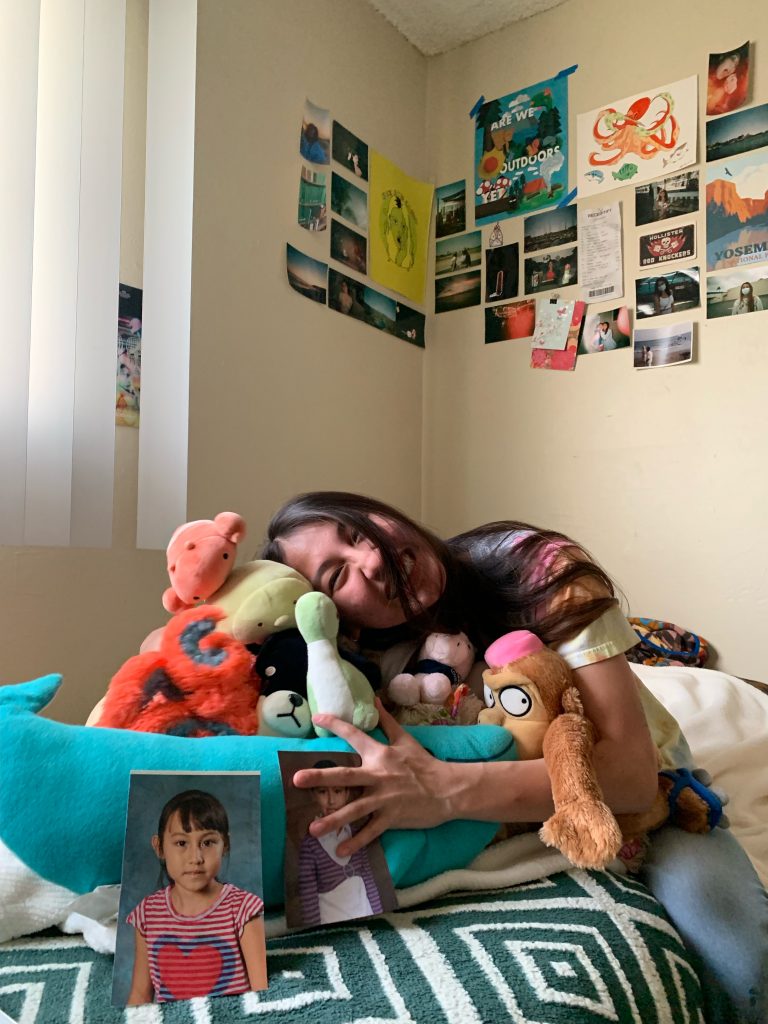
By: Jillian Russell
Place your hand over your heart. Then imagine a time when your 10-year-old self felt emotional wounds. Now, imagine your adult self coming to console your child self. As an adult, you might be years away from the difficult memory, but this hurt child is still you, according to a step-by-step healing exercise led by digital creator, Stacy Li – more widely known as @internetstacy to her followers on TikTok.
“feel fully! its ok if you cry – that’s a sign of emotional release 💕” Li captions in her 2020 video while Powfu and beabadoobee’s popular TikTok tune “death bed (coffee for your head)” plays in the background.
Li, whose TikTok bio describes her online presence as all things “mental health & intentional living,” is just one of the app’s many social media creators posting content under the hashtag #innerchildhealing, which has amassed over 321 millions views and counting. This inner child healing video alone – one of many from Li’s account – has received over 2,000 comments from TikTok users.
“holy I didn’t expect it, but instant tears,” a user by the name of @rezzyndn writes. “I wish someone would have protected me.”
Another user by the name of @cokayne_dreams comments, “I just legit can’t remember most of my childhood.”
These are just some of the many conversations about childhood trauma and mental health that are sprouting on TikTok message boards. In the mental health world, inner child healing is the process of addressing and accepting internalized trauma from childhood in adulthood, also commonly referred to as childhood trauma healing.
According to the American Psychological Association, a traumatic event is one that threatens one’s health and safety and causes feelings of fear and helplessness at the time of its occurrence. In 2018, the Substance Abuse and Mental Health Services Administration’s National Child Traumatic Stress Initiative reported that by age 16, two-thirds of children report experiencing at least one traumatic event. If trauma is left untreated in childhood, it can manifest itself in adulthood, causing emotional responses such as depression and anxiety, physical symptoms such as poor concentration and illness, or behavioral shifts such as compulsiveness or general disorientation among other symptoms.
In January 2021, 41% of adults reported symptoms of anxiety and or depressive disorder. That percentage has been largely stable since spring 2020 – the height of the COVID-19 pandemic. At a time when the future was uncertain, people began looking to their pasts, unveiling long-held childhood traumas.
In January 2021, 41% of adults reported symptoms of anxiety and or depressive disorder.
Dr. Julie Cederbaum is an associate professor in the Suzanne Dworak-Peck School of Social Work who focuses on the impact of childhood adversity on youth well-being. She said that the pandemic caused people to feel isolated and disconnected from their set social networks. Cederbaum also explained that quarantine was especially difficult for young adults between the ages of 18 and 25 who might have had to leave behind independent environments like college to move back into their family homes.
“I think we inherently need people and sometimes the people we need are not the people that we were born into,” Cederbaum said. “But it’s the communities we’ve built and so I think that raised a lot of challenges for people.”
When these challenges arose, people also had immense downtime. With nowhere else to go, Cederbaum said they turned to TikTok for entertainment and comfort.
Cederbaum said that TikTok creators who produce inner child healing content might be “well-intentioned,” but certain videos can be more harmful than helpful, especially if they do not include disclaimers about their experience in therapy or links to other mental health resources.
“I think those content creators are saying this is something that maybe has worked for me and so I want to share it,” Cederbaum said. “But likely it worked for them because somebody worked with them to do it and I think that’s the part that’s missing.”
“Trauma” has been coined the word of the decade and is often discussed on social media apps like TikTok. Dr. Cederbaum explains the nuances of trauma and why it doesn’t carry a one-size-fits-all approach. Listen to her explanation below.
Regardless of the trauma experienced by a person, Cederbaum said that TikTok videos that invite people to revisit painful memories, like the one from Li, could unintentionally cause people to “re-traumatize” themselves without providing them ways to regulate their emotions after.
“I don’t think it’s particularly wise to kind of open Pandora’s box without knowing you have a structure in place to really support you,” she said, “through the emotions or the experiences that might come from opening that door back up and reflecting back and then having to process through it.”
Li’s inner child healing exercise video received many supportive comments from TikTok users who felt enlightened by the practice. But it also received comments from users who felt uncomfortable being asked to re-enter traumatic events in their lives.
“as soon as i reached 2nd step, i said ‘i’m not doing that’ and start crying gn,” writes a user by the name of @liizhette.
Another user named @lunarae_ also shares that their childhood was too traumatic to reflect upon: “When I try to think of the bad times it’s just black. I think my brain blacked it out bc it was too painful.”
One user @4everalonerawr simply comments “I’m scared to try this.”
This is exactly why TikTok self-help videos, while supportive in theory, cannot fully substitute for psychotherapy, Cederbaum said. She also said that working with licensed mental health professionals allows patients to safely reflect and cope through traumatic events from their life at their own pace with set practices to help support them thereafter.
A 20-second TikTok does not offer that same specialized approach, especially when it finds people via a social media algorithm based on likes and favorites.
“We would never push people to keep going and going,” said Cederbaum when explaining the professional therapy process. “And so I wasn’t clear based on what I saw [from TikTok creators] that people would know how to say, ‘I’ve done enough today.’”
“We would never push people to keep going and going,” said Cederbaum when explaining the professional therapy process. “And so I wasn’t clear based on what I saw [from TikTok creators] that people would know how to say, ‘I’ve done enough today.’”
Dr. Suh Chen Hsiao is a clinical assistant professor at the USC Dworak-Peck School of Social Work focused on adults and healthy aging with expertise in mental health. Hsiao agrees that TikTok creators sharing their experiences and advice about healing childhood trauma are helping to raise mental health awareness. But the facts must always come first.
“I think it’s opening up the conversation, opening up their self-awareness,” she said. “And after that, we open up a can of worms.”
Hsiao also expressed the importance of providing follow-up resources such as links to telehealth programs and specialists.
“You want to kind of have an intervention or resources available because I feel like ethically, if you are going to go [discuss] trauma, you’ve got to be prepared for what the next step is,” said Hsiao.

Outside of her work with USC, Hsiao has also worked as a therapist for children within the Los Angeles Unified School District as well as with adults with untreated trauma for over 20 years. She said that today’s medical field provides more trauma-informed practice than ever before and it all begins with the child.
“As we kind of learn more, the child is in a big system,” she said. “So now I think we’re turning into a whole child perspective – whole person perspective.”
“As we kind of learn more, the child is in a big system,” Hsiao said. “So now I think we’re turning into a whole child perspective – whole person perspective.”
Hsiao also explained that modern mental health professionals are dedicated to evaluating children’s environments and finding the best coping mechanisms that are specific to them.
Hsiao said there is no wrong way to heal the inner child as an adult since everyone carries different experiences. But she also believes that storytelling will always be key in helping people move forward.
“An adult has so much story, so much wisdom,” she said. “And having to write about their life story can be very healing because they can remember the good times they have, the positive, the good quality of life they have.”
For others, the process of inner child healing can become spiritual. Lisa Roman is a Los Angeles-based angel communicator and an intuitive healer who has worked with clients to heal their inner child for 25 years.
“Childhood healing is about your child, which is you – I don’t even call it inner child – you’re still that child,” she said. “But we can re-grow it with grown-up tools.”
By “grown-up tools,” Roman means guiding her clients through meditations and exercises where they can reflect on childhood experiences and ask their inner child questions.
“Childhood healing is about your child, which is you – I don’t even call it inner child – you’re still that child,” she said. “But we can re-grow it with grown-up tools.”
Roman also stresses that every child comes into the world with a purpose to teach compassion. But she said that rigid family dynamics, societal pressures, and other traumas, such as being raised by abusive or alcoholic parents, can diminish that purpose.
“That child is now damaged for not being able to be a child,” Roman said.
Roman believes that the devastation of the COVID-19 pandemic inspired people to find pockets of joy in alternative ways – through art, music, cooking. She said that many were able to return to their original childhood passions and some even shared their passions online.
“That’s why TikTok is addressing inner child, because it’s play. It’s pantomime,” she said. “And it’s a lot of playful stuff – what [TikTok users are] doing because they didn’t do that when they were younger.”
Despite the growing buzz around inner child healing on TikTok, some social media users have been able to benefit from these online conversations.
Nicky Vidaca, an 18-year-old Buena Park resident, had never heard about inner child healing. At least not until several videos – TikToks about how childhood experiences impact how adults react to conflict – began frequenting her “for you page.”
“I never thought that the way you responded to things as a child could go into how you respond as you get older,” she said.
Vidaca describes herself as outgoing and talkative today, but she wasn’t always this way. For most of her childhood, she said she didn’t feel like she had a voice. Vidaca was born and raised in Mexico until her mother married her stepfather and they moved her and her younger sister to Guam – a small U.S. island territory in the Western Pacific. While she doesn’t specify details about her stepfather, she says he was physically and verbally abusive and was later sentenced to time in prison.
During that emotionally turbulent period in her adolescence, Vidaca didn’t feel like she could confide in her mother who carried traditional values and wasn’t as open to sharing about mental health.
“My mom’s Latino, it’s harder for [people of color] to open up to their parents,” she said. “Because they’ve all had struggles that are really hard to open up with each other about.”

Outside of her household, Vidaca found herself in another restrictive environment. In Guam, she attended a private Catholic school where she learned that abortion and homosexuality were “wrong.”
“I honestly used to let them control all my thoughts really,” she said. “I used to want to be a sister, like I was going to join the convent and pray every day, you know?”
Vidaca is still Catholic, but she said she has a greater understanding of who she is. At age 15, Vidaca, her mother and her sister moved to the U.S., allowing her family to distance themselves from her stepfather’s abuse and craft a “new beginning.”
Once in California, Vidaca attended public school and quickly became surrounded by other American teens who were more open to expressing themselves. Away from the restrictive environments back in Guam, she was finally able to outwardly share her voice as well as new parts of her sexuality.
“I am gay, but it was a lot to come to terms with, because it was wrong in my eyes growing up,” she said.
If Vidaca could go back and console her child self, it would be when she first moved to the U.S. Listen to her testimonial below.
Vidaca is only starting to unpack a lifetime’s worth of trauma in adulthood.
“I think I’m lucky enough to be one of those people that understands now it’s never too late to start helping yourself heal,” she said. “Because the longer you let it go on, you are going to grow into some nasty things.”

“I think I’m lucky enough to be one of those people that understands now it’s never too late to start helping yourself heal,” Vidaca said.
Vidaca heals her inner child through activities that remind her of carefree childhood moments. She collects and snuggles stuffed animals, expresses herself through drawing, and occasionally watches cartoons with her younger sister.
Vidaca believes that social media cannot offer mental health services that are specific to everyone’s individual needs, and it can be more about following trends than healing hearts. But still, TikTok opened her to a whole new realm of healing.
“I feel like it is really helpful, though, for some people who seek professional help and that they can find comfort in those videos because it’s like a free resource,” she said.
Vidaca said that she is finally starting to come to terms with who she is in every aspect of her identity. As she continues healing from past traumas, she always knows how to access her inner child even if that means a few spontaneous frolics through the playground with her sister.
“You got to go to a park, and you got to go on the swings, and you got to just try to go as high as you can…” she said. “It just makes you feel really youthful and like a little kid with no worries.”